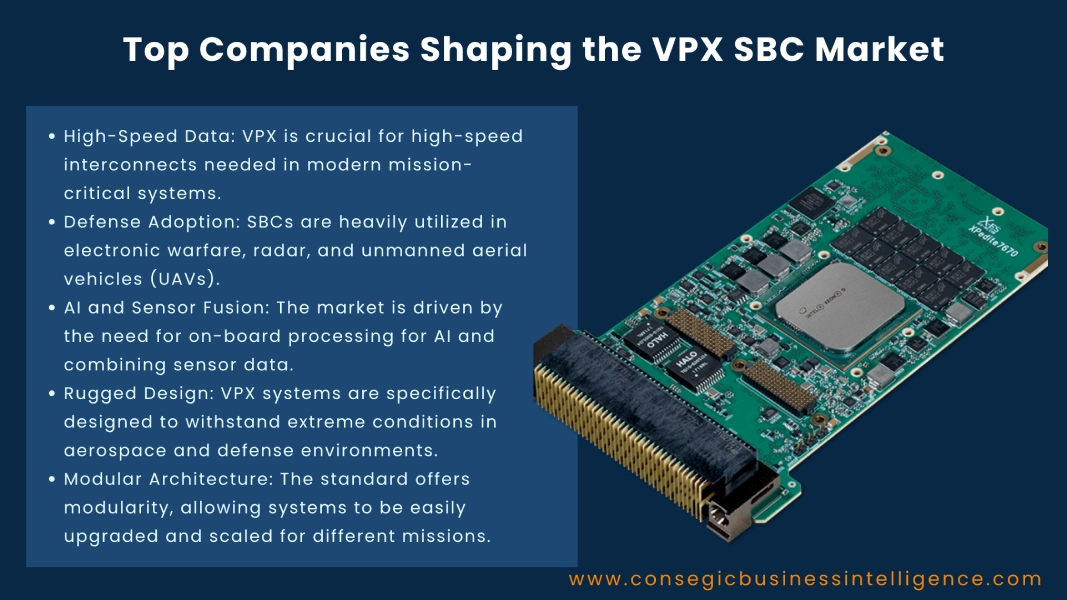Top Companies Shaping the VPX SBC Market
VPX Single Board Computers (SBCs) are advanced embedded computing platforms designed to deliver high performance, modularity, and ruggedness. Built on the VPX standard, these SBCs support high-speed interconnects and open architectures, making them essential for mission-critical applications. They are widely deployed in aerospace, defense, industrial automation, and high-performance computing environments where reliability and processing power are non-negotiable.

The VPX SBCs Market is expanding rapidly as industries embrace technologies like AI, sensor fusion, and autonomous systems. Rising demand for compact yet powerful computing solutions in areas such as avionics, electronic warfare, and unmanned vehicles is pushing innovation further. Against this backdrop, several global players are at the forefront, developing cutting-edge SBCs that combine speed, scalability, and resilience.
In this Blog, we will highlight the top companies shaping the VPX SBC market globally.
- Curtiss-Wright Defense Solutions
Curtiss-Wright is a market leader in ruggedized embedded computing. Its VPX SBCs deliver high-performance processing with multi-core CPUs and GPUs optimized for aerospace and defense applications. The company emphasizes open standards, modular architectures, and cybersecurity features, making its products widely adopted in avionics, C4ISR systems, and unmanned platforms.
- Abaco Systems (an AMETEK company)
Abaco Systems provides advanced VPX SBCs for defense and industrial applications. Its product line integrates Intel and ARM processors with support for high-speed fabrics. Known for reliability and long lifecycle support, Abaco designs are often used in mission-critical applications such as radar, electronic warfare, and advanced sensor processing.
- Mercury Systems
Mercury Systems specializes in secure and rugged embedded computing solutions. Its VPX SBCs are tailored for applications requiring trusted computing, sensor fusion, and AI-enabled decision-making. Mercury’s focus on integrating hardware and software with strong cybersecurity features makes it a preferred partner in U.S. defense modernization initiatives.
- Elma Electronic
Elma Electronic is a key supplier of modular embedded systems, including VPX SBCs. The company focuses on providing open architecture solutions that comply with SOSA (Sensor Open Systems Architecture) standards. Elma’s SBCs are widely used in defense and industrial markets where customization, ruggedness, and interoperability are essential.
- Kontron
Kontron, part of S&T Group, offers VPX SBCs designed for aerospace, transportation, and industrial automation. Its focus on scalability, energy efficiency, and long lifecycle support makes its SBCs attractive for both defense and commercial applications. Kontron also integrates advanced security features to meet evolving industry standards.
- General Micro Systems (GMS)
General Micro Systems develops rugged SBCs with high computing density and low size, weight, and power (SWaP) profiles. Its VPX offerings are optimized for harsh environments, making them suitable for military vehicles, aircraft, and naval systems. GMS emphasizes innovation in thermal management and modularity for next-generation embedded computing.
- Extreme Engineering Solutions (X-ES)
X-ES is recognized for its high-performance VPX SBCs designed for rugged and military-grade systems. Its products support the latest Intel and NXP processors, providing enhanced compute performance in compact, modular designs. X-ES is particularly strong in providing customizable solutions that meet strict defense and industrial requirements.
- Concurrent Technologies
Concurrent Technologies offers VPX SBCs optimized for high-performance computing in military, aerospace, and security markets. Its products emphasize reliability, longevity, and compliance with industry standards. Concurrent’s SBCs are often used in applications requiring real-time processing and deterministic performance.
- ADLINK Technology
ADLINK provides VPX SBCs with a strong focus on embedded AI, industrial automation, and defense markets. Its SBCs integrate advanced GPUs and CPUs, enabling edge AI processing in rugged environments. ADLINK’s strong global presence makes it a trusted supplier across multiple industries, including transportation and communications.
- North Atlantic Industries (NAI)
NAI develops rugged VPX SBCs with flexible and modular designs. Known for its configurable I/O and low-SWaP solutions, NAI’s SBCs are widely used in aerospace and military applications. Its systems are designed for rapid deployment, ensuring operators can meet evolving mission requirements quickly and effectively.
Conclusion
The VPX SBC market is expanding as industries demand more powerful, rugged, and modular computing platforms. Companies like Curtiss-Wright, Abaco Systems, Mercury Systems, Elma Electronic, Kontron, General Micro Systems, X-ES, Concurrent Technologies, ADLINK, and North Atlantic Industries are leading this growth with innovative products tailored for defense, aerospace, industrial, and AI-driven applications. By combining high performance with rugged designs and open standards, these players are ensuring VPX SBCs remain central to mission-critical operations worldwide. As the need for advanced computing power in harsh environments continues to rise, these companies will shape the next wave of innovation in the global VPX SBC market.
